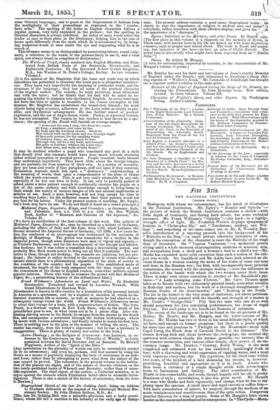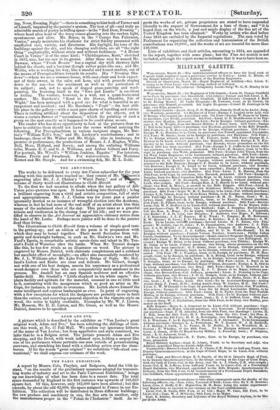,flut
THE NATIONAL AL INSTITUTION.
[sEcoxis zioncs..]
Shakspene, with whom we recommence, has his batch of illustrators in the National Institution. Mr. Egley's " Hamlet and Ophelia "- the picture of which the British Institution contains a sketch—with little depth of treatment, and flaring hard colour, has some technical successes. Mn. Frank Williams's " Ophelia"-.—also hard—is a highly- wrought effect of light. Mr. Frederick Weekes displays symptoms of humour in " Christopher Sly," and " Touchstone, Audrey, and Wil- liam "; and something of the same comes out in Mr. E. Wensley Rust sell's introduction of a capering peacock into the background of his Malvolio in the Sun,"—a. small picture otherwise indicative of care, though the conception of the character is more the Malvolio of the stage than of literature. On " Vanities Vanitatum media:mai person sitting amid a whole museum of incongruities, emblems of sciences, arts, and occupations, from a skull and a woman's foot.to a child's toy—Mr. Marks has expended mere solid execution than such a notion of the sub- ject was worth. Mr. Smallfleld and Mr. Aahhy have both. selected an ob- vious theme in a woman reading the news of the death of some one new and dear, in the Russian war; the. first, with incomparably more pictorial competence, the second with the stronger feeling ;—note the difference in the action of the hands with which the two women cover their faces, There is some very choice execution in another of Mr. Smallileld'At.piel Lures—" A Lady arranging some Flowers." Mr. Cave Thomsa again takes us to Russia with two elaborately-painted heads, somewhat metallic in flesh-tint and surface, but the work of a thorough draughtsman—" Russian. Dealer of the Gostvinordor," and " Dealing in the North." The fur in the former is the very acme of imitation, yet above pettiness. Another single head painted with the breadth and strength of a master in Mr. Crablo"s " Orange-Girl." Pity that the man who can do so well should perpetrate his two remaining performances, the dregs of vapid Ettyism. But such palsy is the beneficent Nemesis of imitators. The cream of the landscape art is to be found.in the oil-pictures of Mr. Hulme, Mr. Dearle, and Mr. Hargitt,. and the water-colours of Mr. Boyce. Mr. Hulme has two or three in hia usual delicate style, of which we have said enough on former occasions : but there is a poetic quality far more rare and precious in " Twilight on the Mountains—scene near Capel Curig, the Black Arm of Carnedd David in the distance." The stream flowing dark and silent between the rock-gorge, the mottled. sky. spattered with crimson clouds, the intense (possibly too intense) like of the remoter mountains, and various other details, show power of an un. common range. Mr. Dearle's " Conway, North Wales," is the most completed and advanced work he has exhibited; sparklingly fresh in tone, with a charming and vivid expression of rippling water, and a moat truly vaporous every-day sky. The repetition, for the third time within two years, of the incident of a bird skimming the stream, is, however provoking, beautiful and appropriate as it is in itself. Artists who thus issue a currency of a single thought stride with seven-league boots to barrenness and futility. The other contribution of Mr. Dearle is less remarkable, and tends, though happily still far off, to pretty flimsiness of style ; nevertheless, it also has great merit. Mr. Barg* is a man who thinks and feels vigorously, and stamps what he has to say plump upon the canvass. A small space and rapid execution suffice him— with more consultation of nature, we suspect, through the medium of as acute reminiscence and sensitiveness, than of the optic retina. Dangerous practice this even for a man of genius. Some of Mr. Hargites little views border-on the coarse and mechanical in consequence. In "TheOycle--Morn-. ing, Noon, Evening, Night "—there is something to hint both of Turner and of Linnell, impaired by the painter's system. The best of all—and truly an admirable snatch of poetry in trifling space—is the "Red Deer, Evening " ; 'where head after head of the troop comes glancing into the sunken light, spontaneous and alive. Mr. Boyce, in the " Campo San Falernian, Venice," amply maintains his character for strict fidelity presented with unaffected ease, variety, and directness. His daylight, his tone of the buildings against the sky, and his changing wan-tints, are all "the right thing" emphatically, without strain and without feebleness. "A House Court in Venice" is of the same kind; " Chiddingstone, Kent," sketched in 1852, nice, but too raw in its greens. After these may be named Mr. Dawson, whose "Fresh Breeze" has a capital sky with showery light behind the clouds, and a buoyant though rather paint-like sea ; and Mr. Webbe, who is working his way, like a manful and honest student, out of the means of Prreraphaelitism towards its results. His " Evening Sha- dows"—where we see a summer-house, with easy-chair and book expect- ant of their owner, in the calm soft hour, and with grounds sloping down to the sea—has the sentiment as well as the portraiture of its subject ; and, not to speak of dogged grass-painting and wool- painting, the browsing lamb in the "Ewe and Lambs" is excellent in feeling. The verdure, however, is a wall, not a quasi-horizontal surface. Mr. Burchett's "Road to the Downs, Shanklin, Isle of Wight," has been managed with a good eye for what is beautiful in ar- rangement and incident; and Mr. Burcham's "Fruit"—the best still- life piece in the gallery—with a most pure charm of handling and colour. There is nothing artificial about the disposition of the objects, yet it wants a certain flavour of "naturalness," which the painting of such a group on the spot exactly as it happened to lie could alone secure.
The reader who has more opportunity to look at the pictures than we have to criticize them should not leave the rooms without noticing the following. For Pra3raphaelitism in various incipient stages, Mr. Bur- ton's " William Tell's Son," and Mr. Lockyer's contributions ; and in landscape, those of Mr. Walter and Mr. Sleigh. Also in landscape, for promise or performance, the productions of Messrs. J. T. Hughes, Willis, Dell, More, Holland, and Raven ; and among the unfailing Williams tribe, Messrs. E. C. and G. A. Williams, and Arthur Gilbert and Percy. For portrait, Mr. Wivell's " William Jenkins, Esquire." For interiors, Messrs. Previa and Swarbreck. For water-colours, Miss Marianne Kernot and Mr. Steeple. And for a swimming fish, Mr. H. L. Rolfe.



























 Previous page
Previous page